"Procrastination is the thief of time", professional salepeople need to be ruthless with their time but generous with people.
Relationship building requires an element of 'chatting' and small talk but we need to keep it under control.
I wonder how many hours though will be spent talking about Wales' demolition of England in the Rugby, the Australian Grand Prix F1 , Lampard scoring his 200th goal for Chelsea. this morning, -- perhaps more than is really needed ?!
I wonder how many hours though will be spent talking about Wales' demolition of England in the Rugby, the Australian Grand Prix F1 , Lampard scoring his 200th goal for Chelsea. this morning, -- perhaps more than is really needed ?!
Maybe this issue is less of a worry for those in desk based sales these days but there are still plenty of professionals in selling expected to get out there and meet customers, press the flesh and 'knock on doors'.
( This slide came from some research years ago when there were more salespeople 'on the road' but for those still involved in field selling they might prove interesting.)
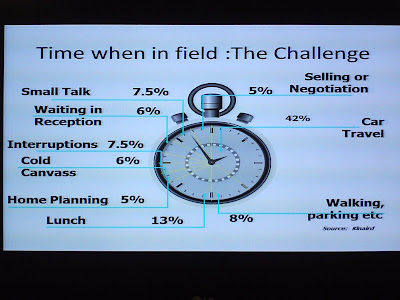
It got me thinking again about making best use of time.
How much time do we have available to us in selling?
( This slide came from some research years ago when there were more salespeople 'on the road' but for those still involved in field selling they might prove interesting.)

It got me thinking again about making best use of time.
How much time do we have available to us in selling?
Here is a typical example of a delegate's calculation I see on courses.
You could well have even less time than this example if you have over 20 days holiday entitlement, more time on administration, processing emails or longer periods of technical, product training and sales skills training etc.
Part A - How days many days available for field selling?
Total number of days available = 365 days
Less weekends .......................................................104
Less annual holidays............................................... 20
Less bank holidays..................................................... 8
Less training days ......................................................5
Less trade days ( Exhibitions, shows etc.) ...............10
Less conference days , sales meetings .......................3
Less sick days .............................................................4
Allow for Planning Days (1 per month)................... 12
Allow for ?
You could well have even less time than this example if you have over 20 days holiday entitlement, more time on administration, processing emails or longer periods of technical, product training and sales skills training etc.
Part A - How days many days available for field selling?
Total number of days available = 365 days
Less weekends .......................................................104
Less annual holidays............................................... 20
Less bank holidays..................................................... 8
Less training days ......................................................5
Less trade days ( Exhibitions, shows etc.) ...............10
Less conference days , sales meetings .......................3
Less sick days .............................................................4
Allow for Planning Days (1 per month)................... 12
Allow for ?
Total........................................................minimum.200 days
Net time available (200 days x 8 hour day) ...............1,600 hours
Part B
Time usage per day:
Travelling ...................................................................3 hours
Waiting for meetings .................................................2 hours
Administration...........................................................1/2 hour
Emails ........................................................................1/2 hour
Other
(@ hours per day x net available)
Part B
Time usage per day:
Travelling ...................................................................3 hours
Waiting for meetings .................................................2 hours
Administration...........................................................1/2 hour
Emails ........................................................................1/2 hour
Other
(@ hours per day x net available)
Part B How much time available for face to face selling?
Part B total time spent - ................................................6 hours
Part B total time spent - ................................................6 hours
Total hours available to sell face to face........................2 hours
Total time available (Part A - Part B) per year 2 X 200 400 hours
Total time available (Part A - Part B) per year 2 X 200 400 hours
Available time by year in days represents just 50 days. Or to put it another way 13% of the year is available for face to face selling.
Journey Planning for the many who still have to travel- "Road warriors".
Sat-nav may have made the skill of map reading redundant, but journey planning skills were only ever part of the skill of sales territory management. To manage a geographical sales territory you need a map to get the big picture into your head.
To be fully cost effective field salespeople need to maximise total face-to-face selling time (or phone contact time where this is an alternative).
Journey Planning for the many who still have to travel- "Road warriors".
Sat-nav may have made the skill of map reading redundant, but journey planning skills were only ever part of the skill of sales territory management. To manage a geographical sales territory you need a map to get the big picture into your head.
To be fully cost effective field salespeople need to maximise total face-to-face selling time (or phone contact time where this is an alternative).
With the rise of Selling 2.0 more selling is done from a desk base whether from home office or at a conventional office. However in many sales processes there is still a point where face to face meetings and presentations have a critical contribution to the process.
This means minimising travelling time and unproductive or wasted time, and ensuring that you are spending your face-to-face selling time productively.

QUALIFYING CLIENTS AND PROSPECTS
One approach is to allocate the number of calls and the amount of time devoted to your clients and prospects in direct proportion to their actual or potential business volume. One popular grading system is
- A : large clients/prospects
- B : medium clients/prospects
- C : small but expanding
- D : small but diminishing.
Ensure that the A's and B's receive most of your attention but that the C's and D's are not completely neglected. Remember that the total time you devote is made up of the NUMBER OF CONTACTS and the AVERAGE DURATION of those contacts.
You must also spend your time with the right people, who can either be DECISION MAKERS or DECISION INFLUENCERS or a combination of the two. Do not waste much time with those who have neither authority nor influence, but equally you must never make enemies of them by ignoring them completely.
Deciding how much time to spend on each client or prospect is the first step.
Then you have to decide how and where to contact them. Contact by telephone and/or mail is never as good as a personal visit. But it is better than nothing and can be a cost effective way of cutting down the total amount of personal selling time needed, especially with C's and D's. But you need a good territory planning technique for fitting in as many personal calls as possible, and also leaving you enough flexibility to respond to urgent requests. Because territories differ so much in size, layout and client density there is no single technique that works for everyone - you have to work out one that suits your circumstances.
One good basis for a plan is to sub-divide your territory into five separate segments allowing for client density, client grades, distances and travel times from your base. Aim to equalise your daily work load rather than equalising geographical areas. You can then set up a simple weekly cycle such as one of those shown in in Fig 2 below.
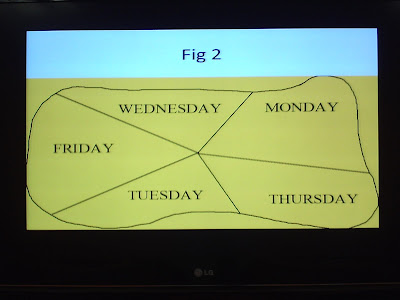 A more sophisticated four-weekly rotating call pattern is shown in Figure 3.
A more sophisticated four-weekly rotating call pattern is shown in Figure 3.
Sub-divide each segment into individual journeys. Each sub-segment will contain one day's work so that, in a four-weekly rotation, the call pattern could be as in Figure 3.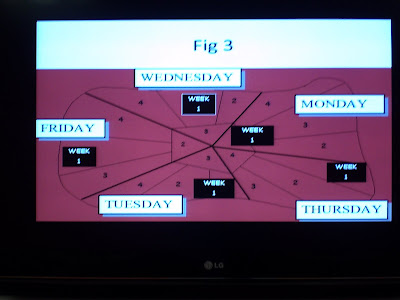
This uses the same concept as 1 and 2 so that calling back on good prospects or customers is made more feasible.
For a larger territory with varying concentrations of clients or prospects, you can use the sort of pattern shown in Figure 4 which shows how the method can be applied to a large territory with varying concentrations of customers/prospects.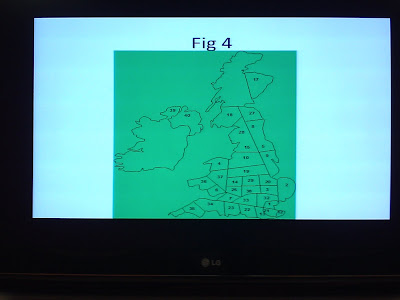
Save time by efficient journey planning. Try to use the "petal" approach in your daily route planning as per the solid line in Figure 5 rather than the "out and back" approach as shown by the dotted line.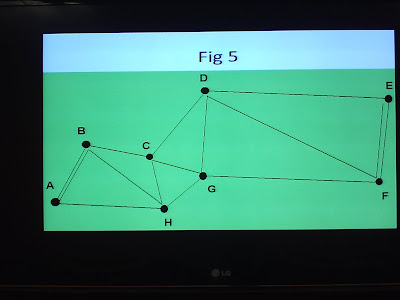
Other techniques for saving time, or using it more efficiently, are
- make your first call earlier
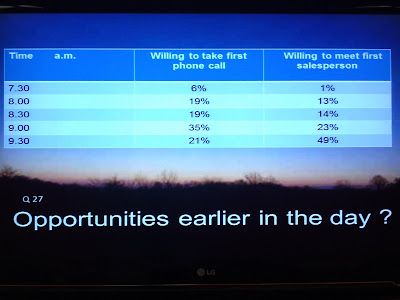
This means minimising travelling time and unproductive or wasted time, and ensuring that you are spending your face-to-face selling time productively.

QUALIFYING CLIENTS AND PROSPECTS
One approach is to allocate the number of calls and the amount of time devoted to your clients and prospects in direct proportion to their actual or potential business volume. One popular grading system is
- A : large clients/prospects
- B : medium clients/prospects
- C : small but expanding
- D : small but diminishing.
Ensure that the A's and B's receive most of your attention but that the C's and D's are not completely neglected. Remember that the total time you devote is made up of the NUMBER OF CONTACTS and the AVERAGE DURATION of those contacts.
You must also spend your time with the right people, who can either be DECISION MAKERS or DECISION INFLUENCERS or a combination of the two. Do not waste much time with those who have neither authority nor influence, but equally you must never make enemies of them by ignoring them completely.
Deciding how much time to spend on each client or prospect is the first step.
Then you have to decide how and where to contact them. Contact by telephone and/or mail is never as good as a personal visit. But it is better than nothing and can be a cost effective way of cutting down the total amount of personal selling time needed, especially with C's and D's. But you need a good territory planning technique for fitting in as many personal calls as possible, and also leaving you enough flexibility to respond to urgent requests. Because territories differ so much in size, layout and client density there is no single technique that works for everyone - you have to work out one that suits your circumstances.
One good basis for a plan is to sub-divide your territory into five separate segments allowing for client density, client grades, distances and travel times from your base. Aim to equalise your daily work load rather than equalising geographical areas. You can then set up a simple weekly cycle such as one of those shown in in Fig 2 below.
 A more sophisticated four-weekly rotating call pattern is shown in Figure 3.
A more sophisticated four-weekly rotating call pattern is shown in Figure 3.Sub-divide each segment into individual journeys. Each sub-segment will contain one day's work so that, in a four-weekly rotation, the call pattern could be as in Figure 3.

This uses the same concept as 1 and 2 so that calling back on good prospects or customers is made more feasible.
For a larger territory with varying concentrations of clients or prospects, you can use the sort of pattern shown in Figure 4 which shows how the method can be applied to a large territory with varying concentrations of customers/prospects.

Save time by efficient journey planning. Try to use the "petal" approach in your daily route planning as per the solid line in Figure 5 rather than the "out and back" approach as shown by the dotted line.

Other techniques for saving time, or using it more efficiently, are
- make your first call earlier

- make your last call later
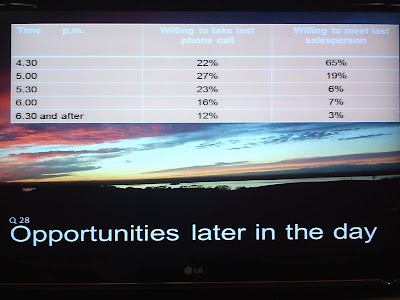
- have the right equipment in your car and at home for keeping your paperwork, records, sales
aid, etc well organised
- always have with you some "time fillers" -
short or easy jobs which can be done in time periods that might otherwise be wasted (eg long delays in reception, cancelled appointments, arriving at client's premises too early)
- fill up your petrol tank at the end of each day
- have details of contingency calls with you in case an appointment is broken or takes less
time
- use motorways - more miles but less time
travelling
- try to group calls in one area per day and do
multiple calls in one location where
appropriate
- make more use of the mobile to chase orders
and handle queries
- carry maps ( don't just rely on Sat nav) and common sense maintenance items such as de-icer, tool-kit.
Every little bit of time saved on non-productive activities gives an increase in potential face-to-face selling time

- have the right equipment in your car and at home for keeping your paperwork, records, sales
aid, etc well organised
- always have with you some "time fillers" -
short or easy jobs which can be done in time periods that might otherwise be wasted (eg long delays in reception, cancelled appointments, arriving at client's premises too early)
- fill up your petrol tank at the end of each day
- have details of contingency calls with you in case an appointment is broken or takes less
time
- use motorways - more miles but less time
travelling
- try to group calls in one area per day and do
multiple calls in one location where
appropriate
- make more use of the mobile to chase orders
and handle queries
- carry maps ( don't just rely on Sat nav) and common sense maintenance items such as de-icer, tool-kit.
Every little bit of time saved on non-productive activities gives an increase in potential face-to-face selling time
No comments:
Post a Comment